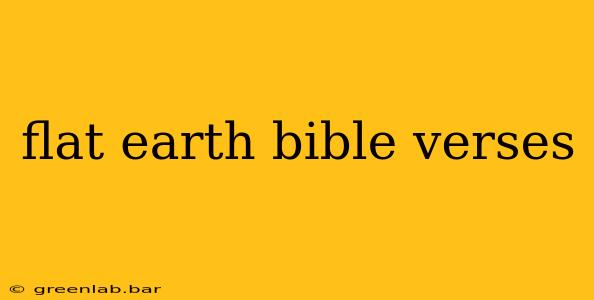Flat Earth Bible Verses: A Critical Examination of Scriptural Interpretations
The claim that the Bible supports a flat-earth model is a common assertion within certain online communities. However, a thorough examination of relevant verses reveals a more nuanced picture, one requiring careful consideration of historical context, literary style, and the limitations of ancient cosmology. This article will delve into commonly cited "flat-earth" verses, analyzing them within their proper context and exposing the misinterpretations often employed to support this view.
Understanding Ancient Cosmology:
It's crucial to acknowledge that the Bible was written during a time when the prevailing understanding of the cosmos was significantly different from our modern, scientifically informed perspective. The ancient worldview, shared across cultures, often depicted a flat earth covered by a dome-like firmament (sky). This doesn't inherently mean the biblical authors believed the earth was literally flat; rather, it reflects the limitations of their scientific knowledge. Interpreting these passages literally, without considering the historical and cultural contexts, leads to misinterpretations.
Commonly Cited Verses and Their Interpretations:
Several verses are frequently cited by those advocating for a flat-earth interpretation of the Bible. Let's examine a few of the most prominent ones:
Isaiah 40:22: "He sits enthroned above the circle of the earth, and its people are like grasshoppers. He stretches out the heavens like a canopy, and spreads them out like a tent to dwell in."
This verse often gets cited due to the word "circle." However, the Hebrew word used, chug, can refer to a circle or a sphere. Ancient peoples often used circular imagery to describe the horizon, not necessarily the shape of the earth itself. Furthermore, the overall imagery emphasizes God's immense power and transcendence, not the earth's geometry.
Revelation 7:1: "After this I saw four angels standing at the four corners of the earth, holding back the four winds of the earth, so that no wind could blow on the earth or on the sea or on any tree."
This verse is often interpreted as evidence of a four-cornered earth. However, this is a figurative description, a literary device used to convey a sense of complete control over the earth and its elements. The "four corners" are not a literal depiction of geography but a symbolic representation of universal dominion.
Other Relevant Passages:
Many other verses describe the earth's features using imagery that aligns with the ancient worldview. These passages, however, should not be taken as literal scientific descriptions. They are primarily concerned with conveying theological truths about God's creation, power, and relationship with humanity. A literal interpretation ignores the poetic and metaphorical language prevalent throughout scripture.
Conclusion:
The assertion that the Bible explicitly supports a flat-earth model is unsupported by a careful and contextualized reading of scripture. The verses often cited are better understood within their historical, literary, and cultural context. While the ancient cosmology described in the Bible differs from our modern understanding, it doesn't necessitate a literal interpretation of every description of the earth's form. Attributing a literal, scientific meaning to figurative language misrepresents both the text and the intentions of the biblical authors. A balanced approach requires appreciating the historical context while understanding the theological message conveyed. Focusing solely on select verses to support a flat-earth theory ignores the broader narrative and misinterprets the biblical text.

